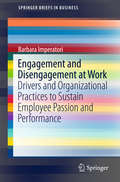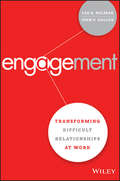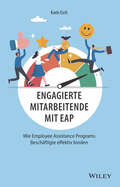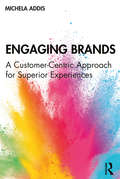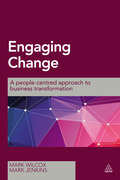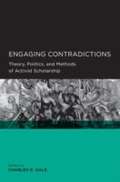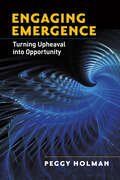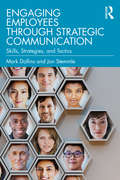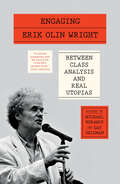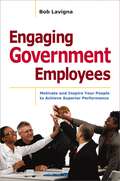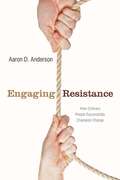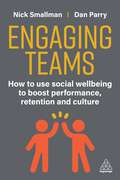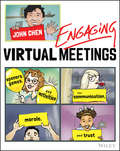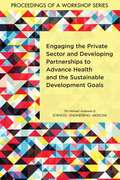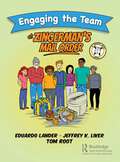- Table View
- List View
Engagement and Disengagement at Work
by Barbara Imperatori*Hotline check pending. At MS submission* This book offers a concise summary of cutting-edge research and practical implications about employee engagement. The author presents a clear perspective on the meaning of employee engagement, its antecedents and consequences are presented with evidences. Based on latest research results, the book discusses organizational practices which enhance people engagement focusing on the new trends of the HRM domain such as well-being practices, e-HRM systems and social volunteering initiatives. The detailed analysis also takes the recent complaints about the HR function into account. This book emphasizes that modern organizations require passionate people to thriving in a rapidly changing world, and it is important to understand why, despite the growing relevance of employee engagement, disengaged persists.
Engagement of Intercultural Project Customers: A Relational Model (Contributions to Management Science)
by Patrick LückmannThis book examines the effective and appropriate integration of project customers in intercultural settings. It first presents the theoretical background and the state of the art in intercultural project stakeholder management. The book then describes the use of qualitative and quantitative (Delphi survey) methods to produce a dataset, and the development of a relational model for customer engagement in intercultural projects based on this dataset. The book can be used to inform future research in the area of international project management, while also serving as a guide for project management practitioners who need to engage culturally diverse users, sponsors and customers.
Engagement: Ties That Bind--Leveraging Consumer Participation
by John A. Quelch Katherine A. JoczMany consumers engage actively with marketers - they talk to market researchers, suggest service improvements, and submit new product ideas. While we tend to think of companies as "producers" and consumers as "receivers," the line between the two is blurred and becoming more so. Just as political democracies are more robust and more representative when citizens engage in public affairs, companies are learning that letting consumers participate in marketing strengthens their competitive position. In a democratizing marketplace, constructive engagement with consumers should be the wave of the future.
Engagement: Transforming Difficult Relationships at Work
by Lee G. Bolman Joan V. GallosMaster the interpersonal side of management to enhance productivity and boost success Engagement is the manager's essential primer for dealing with difficult people and managing your team. Bestselling authors Lee G. Bolman and Joan V. Gallos are back with an engaging business novella that relates real, practical techniques captured in the 4-step SURE model for handling people problems. The story centers around a manager in a new job, and her experiences applying the four steps in leading her new team. Brief interludes punctuate the story throughout to provide room for reflection, and to explain the complex interpersonal dynamics at play in commonly encountered situations. Key lessons are underscored as the foundation for a sound people strategy, and the features and details of each rule are laid out in a clear, concise manner. You'll learn alongside the story's manager as she uses the model to find artful solutions to problems that could have easily derailed her chances of success. People are the hardest part of a manger's job. No matter how well-matched their skill sets, there is always the potential for interpersonal conflicts and strains to throw the team off-course. This book shows you deft strategies for addressing those challenges with a well thought-out framework for getting your team fully invested in the group's success. Find creative solutions to persistent issues Dig into the interpersonal dynamics at work Learn how to handle--and manage--difficult people Apply key strategies for engaging the team This compact, easy-to-apply set of guidelines draws on your leadership skills while providing a strong foundation for a new managerial approach. Effective management is frequently a tightrope between results and morale, and Engagement shows you how to find your balance and steady your team.
Engagierte Mitarbeitende mit EAP: Wie Employee Assistance Programs Beschäftigte effektiv binden
by Karin EschAngebote für Mitarbeitende sind längst Teil des Baukastens im Personalmanagement. Sie reichen vom Obstkorb im Büro über das hauseigene Sport- und Fitnessangebot bis hin zum (eher fragwürdigen) Tankgutschein. Unternehmen versprechen sich dadurch eine bessere Mitarbeiterbindung, mehr Bewerbungen sowie einen Imagegewinn im Sinne des Employer Branding. Häufig wollen sie auch ihrer sozialen Verantwortung stärker gerecht werden. So sensibilisiert Geschäftsführende und Personaler bereits für das Thema sind, so sehr neigen sie gleichzeitig dazu, sich zu verzetteln. Was bringt ein Fitnessstudio, wenn kaum jemand es nutzt? Und muss der Obstkorb gerechtigkeitshalber auch per Paketdienst ins Homeoffice geschickt werden? In wirklich schwierigen Lebenslagen werden Mitarbeitende dagegen oft alleingelassen. Die Suche nach Kinderbetreuung lässt viele Eltern verzweifeln. Coaching steht meist nur Führungskräften zu. Über Suchtprobleme spricht man nicht. Karin Esch zeigt, welche Angebote für Mitarbeitende tatsächlich einen Unterschied machen und Unternehmen auf dem Weg zur sozialen Nachhaltigkeit weiterbringen. Sie plädiert für ein Ende der Beliebigkeit und den Fokus auf das, was Menschen in einer sich wandelnden Arbeitswelt wirklich effektiv unterstützt. Das schließt das sprichwörtliche Sahnehäubchen nicht aus, sofern das Angebot zum Unternehmen passt. Im Mittelpunkt des Buchs stehen vier Praxisfelder: Eltern und Kinder, Pflege, Lebenslagen und Emotionales. Die Autorin stellt größere Kontexte her und eröffnet neue, erhellende Perspektiven. Nach der Lektüre hat die Zielgruppe das Thema Employee Assistance Program (EAP) ganzheitlich durchdrungen und besitzt somit eine solide Basis für die Entscheidung, welche Arten der Mitarbeitendenunterstützung im Unternehmen neu implementiert oder fortgeführt werden sollen.
Engaging Brands: A Customer-Centric Approach for Superior Experiences
by Michela AddisHow can managers design and manage excellent customer experiences that will develop long-term relationships with their customers? This book addresses this key question and explores both the theory developed over the past 20 years and tools to create truly engaging brands. Taking a broad holistic approach, this book brings together current thinking on experiential marketing, brand management, customer engagement, customer well-being and happiness, customer loyalty and emotions, the customer journey map, and big data and combines it into a practical and clear roadmap for brand managers. By integrating these modern perspectives, concepts, research techniques, and operative tools, this book provides a new perspective of marketing management to design and build engaging branding. Using extensive examples from a variety of industries, this book offers a global perspective that will appeal to both advanced students and experienced marketing managers.
Engaging Change
by Mark Jenkins Mark WilcoxAny significant organizational level change initiative is dependent on the engagement of the people working in that organization. Without engagement, change will falter and ultimately fail. Engaging Change goes behind the scenes of change management to help managers, consultants and practitioners understand why some things work and why others don't. Engaging Change addresses current challenges such as how to understand the environmental context driving the need for change; how to initiate and sustain momentum throughout the change programme; how to institutionalize structural and behavioural change; and how to create compelling visions. With case studies from Sony, Nestlé, Redcats (who own La Redoute, for example) and the British Army, the text provides practice-based insights into the realities of leading sustainable change.
Engaging China
by Paul EvansFor more than four decades, engagement has been the bedrock of Canada's policy toward China, as Ottawa has attempted to assist China's entry into the international system and advance a commercial agenda. More than just high policy, engagement has also been a recurrent narrative that sees changing China as a moral enterprise as important as trade and diplomacy. As global China's economic and diplomatic reach has expanded, policy makers in Ottawa have not fashioned an effective response. They are failing to produce a compelling strategy that addresses the power shift underway and growing public anxiety about China at home.Engaging China is a concise account of the evolution and state of the Canadian approach to China, its achievements, disappointments, and current dilemmas. Written by Paul Evans, professor at the Institute of Asian Research at the University of British Columbia and former head of the Asia Pacific Foundation of Canada, the volume inaugurates the UTP Insights series - books that take on the issues crucial to understanding our world and Canada's place within it.Evans's assessment of the evolution of Canada's China policy speaks to the intellectual history of the idea of "engagement," and assesses its internal contradictions and possibilities. He provides the elements of a comprehensive and strategic approach to China's central role in the most important power shift in the global order since World War II.
Engaging Contradictions: Theory, Politics, and Methods of Activist Scholarship
by Charles R. HaleThe primary purpose of this volume is to provide a broad and grounded counterpoint to the standard admonition to students entering social science and humanities graduate training programs: "Welcome, come in, and please leave your politics at the door."
Engaging Emergence: Turning Upheaval into Opportunity
by Peggy HolmanChange is everywhere these days—at times it seems like barely controlled chaos. Yet within this turmoil are the seeds of a higher order. When a new system arises from the ashes of the old, science calls the process "emergence." By engaging it, you can help yourself and your organization or community to successfully face disruption and emerge stronger than ever.In this profound book, Peggy Holman offers principles, practices, and real-world stories to help you work with compassion, creativity, and wisdom through the entire arc of change—from disruption to coherence. You'll learn what to notice, what to explore, what to try, and what mindset opens new possibilities. This work can be challenging but also tremendously rewarding. It enables new and unlikely partnerships and develops breakthrough projects. You become part of a process that transforms the culture itself.
Engaging Employees in the Company's Profits and Their Own: Why Everybody Wins When You Provide Incentives to Your Low-Level Employees
by Jody HeymannThere is a demonstrated advantage in overall business performance among high-engagement companies compared with their low-engagement counterparts. Yet despite persuasive evidence, companies rarely maximize the potential benefits of employee engagement by encouraging it in workers at all levels of the corporate ladder. It's time to unlock the potential increase in customer satisfaction, commercial sales, and diminished turnover rates that engaging and motivating your low-level employees can bring, even in an economic downturn. This chapter shows you how to design a customized incentive program that will increase the engagement and motivation of employees at all levels. It provides dozens of real-world approaches that can be tailored to almost every budget and business model, from all-expenses-paid all-company vacations to simple public recognition of a job well done. Even if you don't have a large budget, this chapter equips you with ways to maximize your return on investment by using targeted incentive programs for specific areas of improvement. This chapter was originally published as Chapter 7 of "Profit at the Bottom of the Ladder: Creating Value by Investing in Your Workforce."
Engaging Employees through Strategic Communication: Skills, Strategies, and Tactics
by Mark Dollins Jon StemmleEngaging Employees through Strategic Communication provides a detailed overview of employee communication and its evolution as a tool to drive employee engagement and successful change management. Approaching the subject with the philosophy that internal audiences are essential to the success of any strategic communication plan and business strategy—particularly as they relate to driving change—Mark Dollins and Jon Stemmle give readers a working knowledge of employee communication strategies, skills, and tactics in ways that prepare students for careers in this rapidly expanding field. Providing the tools necessary to evaluate the impact of successful employee communication campaigns, they put theory and cutting-edge research into action with practical examples and case studies sourced from award-winning entries judged as best-in-class by the International Association of Business Communicators (IABC), the Public Relations Society of America (PRSA), PRWeek, and PRNews. The book is ideal for undergraduate and graduate students in internal, corporate, or employee communication courses and will be a useful reference for practitioners who want to understand how to carry out effective employee communication engagement and change-management campaigns.
Engaging Erik Olin Wright: Between Class Analysis and Real Utopias
by Michael Burawoy and Gay SeidmanA collection of essays exploring emancipatory social science, inspired by the work of pioneering sociologist Erik Olin WrightErik Olin Wright was one of the most brilliant and world renowned social scientists of our era. He left us in 2019 with an unfinished project - the articulation of class and utopia. Wright's sociological Marxism embarked from an original class analysis, with its trade-mark contradictory class locations, that empirically mapped class structures across the globe. In response to the collapse of communism and the rise of neoliberalism, Wright turned to the premise of class analysis, that is the possibility of socialism.Forsaking Marxism's allergy to utopian thinking, Wright searched the planet for institutions that might sow the seeds of socialism – such as cooperatives, participatory budgeting, basic income grants – institutions that might dissolve racial, gender, and class inequalities by eroding capitalism. His last book How to be an Anticapitalist in the Twenty-First Century, published posthumously in over a dozen languages has become a manifesto for a new world, bringing together and inspiring social movement activists.The essays in this volume pay tribute to his generative theory, his crystalline teaching and his personal warmth. The authors – all close colleagues or former students – wrestle with the relationship between his two expanding research programs, class analysis and real utopias. They burn the candle from either end, all galvanized by Wright's genius and vision to reinvent Marxism.
Engaging Government Employees: Motivate and Inspire Your People to Achieve Superior Performance
by Bob LavignaGovernment employees face enormous challenges today, including being stigmatized as underworked and overpaid. At the same time, they're being asked to solve some of our toughest problems including unemployment, security, poverty, and education In Engaging Government Employees, Bob Lavigna gives managers the tools they need to leverage the talents of government's most important resource: its people. He shows them how to measure, nurture, and sustain the kind of authentic employee engagement that drives results. With over three decades of experience in public sector HR, he knows how to get team members passionate about the agency's mission, and committed to its success. Readers will learn: * Why a highly engaged staff is 20 percent more productive * How to get employees to deliver "discretionary effort" * How to assess the level of engagement * Why free pizza and Coke every Friday is not a viable strategy * And more Drawing on a wealth of empirical evidence, Engaging Government Employees rejects the typical, one-size-fits-all approach to motivation and shows how America's largest employer can apply the science of engagement to dramatically improve performance.
Engaging Individuals: People Want to Help--Sustainability Fosters Engagement, Which Fosters Sustainability
by Adam WerbachHighly engaged employees outperform their disengaged colleagues by 20 to 28 percent. They are also more likely to stay in their jobs, thereby reducing replacement costs. The statistics in support of investing in the engagement of your employees go on and on, but few companies take the initiative to move beyond the lowest form of engagement: enforcing mere compliance to the rules. In this chapter, sustainability expert Adam Werbach explains that engagement is broader than just an employee's job satisfaction and that developing sustainability at the level of individual employees can foster happiness and corporate sustainability. As an example of the effectiveness of integrating personal and corporate strategic goals, the author looks at the personal sustainability project he helped start with Walmart's employees. This chapter was originally published as chapter 5 of "Strategy for Sustainability: A Business Manifesto."
Engaging Resistance: How Ordinary People Successfully Champion Change
by Aaron D. AndersonEngaging Resistance: How Ordinary People Successfully Champion Change offers an empirically based explanation that expands our understanding about the nature of resistance to organizational change and the effects of champion behavior. The text presents a new model describing how resistance occurs over time and details what change proponents can do throughout three engagement periods to effectively work with hesitant colleagues. The book's findings are illuminated by examples of six different resistance cases, embedded in the transformation sagas of two real-world organizations. A fundamental premise of this work is that resistance should not be something to avoid or squash as people work to change their organizations. In fact, resistance can be viewed as a natural, healthy part of an organic process. When engaged properly, resisters can help to improve change efforts and strengthen an organization's overall transformation.
Engaging Stakeholders in Education for Sustainable Development at University Level
by Walter Leal Filho Luciana BrandliThis book discusses the role of ESD stakeholders at university level, involving civil society and the private sector and public sectors (including local, national and intergovernmental bodies). In particular, it describes practical experiences, partnerships, networks, and training schemes for increasing the capacity of ESD and other initiatives aimed at promoting education for sustainable development taking place at institutions of higher education. In order to meet the pressing need for publications that may promote stakeholders' involvement in ESD in higher education, the book particularly focuses on state-of-the-art approaches, methods, initiatives and projects from around the world, illustrating the contribution of different stakeholder groups to sustainable development in higher education on an international scale.
Engaging Teams: How to use Social Wellbeing to Boost Performance, Retention and Culture
by Nick Smallman Dan ParryBusinesses are struggling with unprecedented levels of disengagement. According to Gallup, quiet-quitting costs organizations $8.9 trillion in lost productivity. Engaging Teams provides an effective solution to this problem.Large US organizations spend about $11 million a year on wellbeing initiatives, with virtually none making any real difference. Full of extensive analysis of academic research, business data and C-suite insights, Engaging Teams demonstrates how individuals, teams, organizations and leaders can strengthen engagement and get the best from their people.Offering practical guidance and actionable advice, this book provides a step-by-step path to tackling issues like leading through change, multigenerational communication and failures in critical thinking by building healthier and more successful team environments.A blueprint for leaders and HR professionals, the book uses real-world examples from companies including NASA, Microsoft, Citigroup, Johnson & Johnson, Google, Lenovo, Ikea and Qantas to show the value of skills in agile thinking, emotional intelligence, ongoing feedback and problem-solving. Accessible, clear-sighted and far-reaching, Engaging Teams is essential reading for anyone looking to drive motivation, productivity, resilience and retention.
Engaging Virtual Meetings: Openers, Games, and Activities for Communication, Morale, and Trust
by John ChenBuild a cohesive and high-performing virtual team with this fantastic resource full of actionable advice and practical tips Engaging Virtual Meetings: Openers, Games, and Activities for Communication, Morale, and Trust offers concrete strategies and practical tips for bringing teams together across the digital divide. While many struggle to build teams in a virtual environment, accomplished author John Chen has found ways to create team cohesion, promote engagement, and increase virtual participation. In Engaging Virtual Meetings, he shares these methods with you, and also: Describes virtual tools for promoting effective teamwork, like the Participant Map Teaches you to optimize your teleconference setup for ideal audio and video Illustrates ways to apply these methods in any virtual environment, including Zoom, Microsoft Teams, and more Explores how to debrief your participants to improve your methods over time Perfect for anyone working in or with the increasingly prevalent virtual environment, Engaging Virtual Meetings is a great addition to the bookshelves of anyone interested in how to create and build engagement in team settings of all kinds.
Engaging With Stakeholders: A Relational Perspective on Responsible Business
by Adam Lindgreen Joelle Vanhamme Francois Maon Beatriz Palacios Florencio Carolyn Strong Christine VallasterEngaging with Stakeholders: A Relational Perspective on Responsible Business contends that meaningful and constructive stakeholder engagement efforts should be rooted in a deep relational process of shared understanding, expectations, and viewpoints, through honest, continued dialogue between stakeholders and company management. This anthology follows and reaffirms this view, which also establishes the increasing need to explore the subtleties of how companies can respectfully engage their stakeholders in ways that reflect the corporate strategy and contribute to the ongoing development of business activities and creation of value, for themselves and stakeholders, from social, environmental, and economic perspectives. Stakeholder engagement practices, however, remain highly complex and difficult to manage; their ability to generate value in an inclusive way requires critical consideration. Sound stakeholder engagement efforts also constitute a keystone for responsible business activities. Drawing on a wide range of literature and studies, this book addresses key dimensions of stakeholder engagement, through a responsible business lens, and thereby contributes to identifying the opportunities, challenges, and key organizational implications associated with their unfolding. The four main topics covered are: • Delineating the nature and multiple raisons d’être of stakeholder engagement • Dialogical and communicational foundations of stakeholder engagement • Engaging with diverse stakeholders throughout the value chain • Reaping organizational returns and relational rewards of stakeholder engagement efforts
Engaging the Heart in Business: A Revolutionary Market Approach Based On Love (Giving Voice to Values)
by Alice Alessandri Alberto AleoIn the wake of the profound upheavals that our society has been facing, the business world is undergoing change. Values such as trust, well-being, sustainability, and respect for human beings and their deeper ambitions are becoming increasingly important. Corporations and professionals can achieve and maintain success only if they can bring their relationship with their customers to a new, higher level. The condition that links the two is very similar to that created when we fall in love. The organizational models and marketing approaches based on the metaphor of war, and the inherent rhetoric of "command and control", are no longer valid; to form such a bond we need love. The authors are aware of this. Since 2013, in collaboration with international scholars, they have been studying the new market dynamics and the fundamental role of ethics in gaining commercial results. While their previous book Sales Ethics (2015) helped to set up and manage customer relationships based on trust and fairness, this new book will support you in building your business strategy and designing marketing tools (from customer analysis, to the definition of your offer and the style of communication, up to the positioning of prices and the management of resources) in the light of a new model, the Loving Business Model, which aims to make the customer fall in love with you, and you with your work. This book, like its predecessor, is the result of independent research conducted between Italy and the United States combined with the authors’ many years of professional experience. It contains the most up-to-date and effective techniques available in the modern marketing landscape, supported by case studies, concrete examples and activities, which will guide you to put your newly acquired knowledge into practice.
Engaging the Nationwide Workforce
by Ethan S. Bernstein Sarah Mehta Jessica A. GoverNationwide is "on your side," but did employees feel that way? CAO Gale King and CEO Steve Rasmussen, starting in 2008, invested heavily in a human capital strategy centered around "engagement" at the Ohio-based Nationwide Mutual Insurance Company. Set in 2014, this case tells the story of those efforts to bolster employee engagement as a key part of the company's strategy to recover from the financial crisis (which it did far more effectively than most of its peers, rising in the Fortune 500 ranking as a result). From 2008 to 2013, Nationwide has seen employee engagement improve from the third to the sixth decile of Gallup's North American Finance and Insurance workgroup database. The case details the multi-pronged human capital strategy that Rasmussen and King implemented. It concludes by asking students to consider: will a new initiative aimed at moving Nationwide's dozen brand under a single umbrella jeopardize the culture gains that Nationwide has achieved over the last six years?
Engaging the Next Generation of Aviation Professionals
by Steven Hodge Suzanne K. Kearns Timothy J. MavinEngaging the Next Generation of Aviation Professionals is an edited volume that brings together a diverse set of academic and professional perspectives within the three themes of attracting, educating, and retaining the next generation of aviation professionals (NGAP). This compilation is the first academic work specifically targeting this critical issue. The book presents a rich variety of perspectives, academic philosophies, and real-world examples. Submissions include brief case studies, longer scholarly works from respected academics, and professional reflections from individuals who have made important contributions to their field. The book includes academic chapters that explore the topic from a more theoretical standpoint yet are accessible and understandable to a professional audience. These are complemented by both broad and specific practice examples that describe initiatives and applications occurring in the industry around the three themes. All submissions include descriptive insights, experiences, and first-hand accounts of accomplishments, intended to support the work of other professionals managing NGAP issues. This work will be valuable to anyone involved in attracting, educating, or retaining NGAP, including academics, operators, national and international regulators, and outreach coordinators, among many others.
Engaging the Private Sector and Developing Partnerships to Advance Health and the Sustainable Development Goals: Proceedings of a Workshop Series
by Engineering Medicine National Academies of SciencesIn September 2015, the Sustainable Development Goals (SDGs) were adopted at the United Nations Development Summit to serve as a 15-year plan of action for all countries and people. The SDGs include 17 specific goals, and 169 associated targets that set out quantitative objectives across the social, economic, and environmental dimensions of sustainable development, all to be achieved by 2030. Health has been recognized as crucial for sustainable human development and an essential contributor to the economic growth of society. Beyond the goal to “ensure healthy lives and promoting well-being for all at all ages,” many of the other SDGs include targets that are essential to address the environmental and social determinants of health. Considering this context, the Forum on Public–Private Partnerships for Global Health and Safety convened a workshop series to examine potential opportunities to engage the private sector and develop partnerships to advance health and the SDGs. This publication summarizes the presentations and discussions from the workshop series.
Engaging the Team at Zingerman’s Mail Order: A Toyota Kata Comic
by Jeffrey K. Liker Eduardo Lander Tom RootAfter decades of implementing Lean tools, organizations are getting serious about the heart and soul of Lean management. They are developing people to continuously improve. Most of the Lean tools, such as kanban, andon, and visual management, are designed to surface problems so you know what to work on to achieve your goal. Engaged, scientific-thinking team members solve them one by one. Toyota’s underlying assumption is that the world is complex and uncertain, and we never have the perfect solution, so whatever is implemented needs continual refinement as we learn and as the marketplace changes. If we can’t predict what is around the corner, then a key skill is being able to learn and to adapt to what appears. Where do we want to go? How can we ensure that everyone contributes to our journey? This book builds on Lean in a High-Variability Business. It is a shorter, focused introduction to developing scientific thinking through deliberate practice with Toyota Kata (TK). TK has practice routines (‘Starter Kata’) for both the learner trying to change how they approach problems to a more systematic, scientific approach, and the coach trying to teach them by helping them work toward actual goals. The focus is on the HOW of developing engaged managers and supervisors who in turn can develop an engaged workforce. There are many books about why engagement is important and descriptions of best practices, but few provide practical guidance on how to actually achieve it. And there are none in an easy-to-understand comic or graphic form. It is only through deliberate practice that we can develop a new, habitual way of thinking to avoid jumping to conclusions and let the facts and evidence guide us. Here's how one organization does it. You can too.
